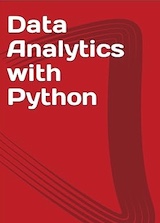
|
FreeComputerBooks.com
Links to Free Computer, Mathematics, Technical Books all over the World
|
|
- Title: Data Analysis with Python (Numpy, Matplotlib and Pandas)
- Author(s): Bernd Klein
- Publisher: Python Course
- Paperback: N/A
- eBook: PDF
- Language: English
- ISBN-10: N/A
- ISBN-13: N/A
- Share This:

|
Understand data analysis pipelines using machine learning algorithms and techniques with this practical guide, using Python. You'll be equipped with the skills you need to prepare data for analysis and create meaningful data visualizations for forecasting values from data.
About the Authors- N/A

- Data Analysis with Python (Numpy, Matplotlib and Pandas) by Bernd Klein
- The Mirror Site (1) - PDF
- Data Science and Analysis with Python (Jesús Rogel-Salazar)
-
 Python for Data Analysis: Pandas, NumPy, and Jupyter
Python for Data Analysis: Pandas, NumPy, and Jupyter
The focus is specifically on Python programming, libraries, and tools as opposed to data analysis methodology. This is the Python programming you need for data analysis. You'll learn the latest versions of pandas, NumPy, and Jupyter in the process.
-
 Learning Pandas: Python for Data Munging, Analysis, Visualization
Learning Pandas: Python for Data Munging, Analysis, Visualization
This book is designed to bring developers and aspiring data scientists who are anxious to learn Pandas up to speed quickly. It covers the essential functionality. It includes many examples, graphics, code samples, and plots from real world examples.
-
 O'Reilly® Python Data Science Handbook: Essential Tools
O'Reilly® Python Data Science Handbook: Essential Tools
Several resources exist for individual pieces of this data science stack, but only with the Python Data Science Handbook do you get them all - IPython, NumPy, Pandas, Matplotlib, Scikit-Learn, and other related tools.
-
 Data Visualization in Python (Daniel Nelson)
Data Visualization in Python (Daniel Nelson)
This is a book for beginner to intermediate Python developers and will guide you through simple data manipulation with Pandas, cover core plotting libraries like Matplotlib and Seaborn, as well as experimental libraries like Altair.
-
 An Introduction to R and Python for Data Analysis
An Introduction to R and Python for Data Analysis
This book helps teach students to code in both R and Python simultaneously. The book is written in an engaging, collaborative style that makes it enjoyable to read. It maintains its formality without creating a barrier between the reader and the content.
-
 Deep Learning with Python, 2nd Edition (Francois Chollet)
Deep Learning with Python, 2nd Edition (Francois Chollet)
This book introduces the field of deep learning using Python and the powerful Keras library. It offers insights for both novice and experienced machine learning practitioners, and builds your understanding through intuitive explanations and practical examples.
-
 From Python to NumPy (Nicolas P. Rougier)
From Python to NumPy (Nicolas P. Rougier)
NumPy is one of the most important scientific computing libraries available for Python. This book teaches you how to achieve expert level competency to perform complex operations, with in-depth coverage of advanced concepts.
-
 Guide to NumPy (Travis E. Oliphant)
Guide to NumPy (Travis E. Oliphant)
This book is for programmers, scientists, or engineers, who have basic Python knowledge and would like to be able to do numerical computations with Python. It will give you a solid foundation in NumPy arrays and universal functions.
-
 NumPy Tutorials (Usman Malik, Anne Bonner, et al)
NumPy Tutorials (Usman Malik, Anne Bonner, et al)
They provide everything you need to know to get started with NumPy. They also explain the basics of NumPy such as its architecture and environment, discusses the various array functions, types of indexing, etc. With examples for better understanding.
-
 Scipy Lecture Notes (Emmanuelle Gouillart, et al)
Scipy Lecture Notes (Emmanuelle Gouillart, et al)
This book is the teaching material on the scientific Python ecosystem, a quick introduction to central tools and techniques. It is for programmers from beginner to expert. Work on real-world problems with SciPy, NumPy, Pandas, scikit-image, and other Python libraries.
-
 SciPy Programming Succinctly (James McCaffrey)
SciPy Programming Succinctly (James McCaffrey)
This book offers readers a quick, thorough grounding in knowledge of the Python open source extension SciPy. The SciPy library, accompanied by its interdependent NumPy, offers Python programmers advanced functions that work with arrays and matrices.
-
 Deep Learning for Coders with Fastai and PyTorch
Deep Learning for Coders with Fastai and PyTorch
This book show you how to train a model on a wide range of tasks using fastai and PyTorch. You'll also dive progressively further into deep learning theory to gain a complete understanding of the algorithms behind the scenes.
-
 Deep Learning with PyTorch (Eli Stevens, et al.)
Deep Learning with PyTorch (Eli Stevens, et al.)
This book teaches you to create deep learning and neural network systems with PyTorch. It gets you to work right away building a tumor image classifier from scratch. You'll learn best practices for the entire deep learning pipeline, tackling advanced projects.





